THE LOST MANSIONS OF BUCA
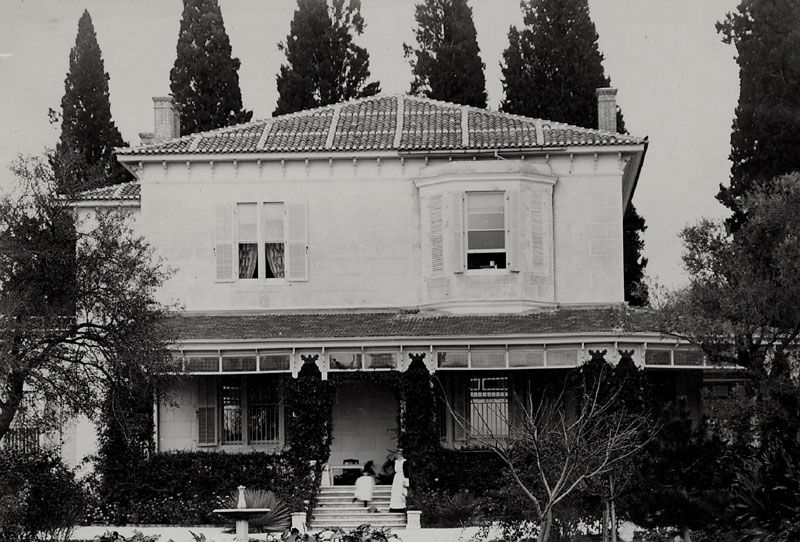
1. Buca's historical heritage
Although the Buca district of Izmir has become a crowded settlement today, it still attracts attention with the preservation of its unique historical architecture to a large extent. Dumlupınar and Yaylacık neighborhoods, which make up the historical Buca, attract people's attention with their houses that are at least a hundred years old and provide some relief to people in Buca, which is known for its crooked construction.
Since Buca was a place preferred by many European families in the past, it hosts many mansions today. Although it is known that families such as Gout, Maltass, Forbes, Rees, De Jongh preferred Buca since the late 1700s and early 1800s due to its suitable climate and location close to Izmir, Levantines (the general name given to Europeans living in the Middle East) ) They started to prefer Buca intensively when it was decided to extend the railway towards Buca in the 1860s. It is known that Sultan Abdülaziz came to Buca in 1863 and the idea of opening a line to Buca was conveyed to him. From this date onwards, Levantines residing in Izmir and surrounding regions began to prefer Buca more. The small village of Buca, which was connected to Seydiköy until then; It will begin to develop over time and will begin to compete with Bornova, leaving behind places close to Izmir such as Seydiköy, Kokluca, Naldöken. As the Levantines began to build magnificent mansions in Buca, Buca gradually moved away from its village appearance and began to become a suburb of Izmir towards the end of the 1800s. The mansions built by the Levantines have become a part of Buca's history.
It is a question mark how many of the mansions in Buca have survived to the present day. The location of the houses of some famous families who lived in Buca has not been determined until today. Among these, the most famous is undoubtedly the Maltass family. Apart from the Maltass family, the exact location of the houses of families such as Corsini and Holton has not been determined. It should not be forgotten that, apart from the Levantines, wealthy Greeks also had mansions in Buca (especially Sevastopoulos, Baltazzi, Issigonis and Spartans). Considering all these factors, it can be said that perhaps half of the historical mansions in Buca have not survived to the present day.
Although it is very difficult to determine how many mansions have not survived to the present day in Buca; We know the names and locations of some mansions that have not survived to the present day through photographs, interviews and various sources over the last hundred years. Some of these mansions were demolished and replaced by apartment buildings, some were converted into parks, and some became ruins, although they were not completely destroyed. We see that the mansions that have survived to this day in Buca did not come as a result of a special effort of the state or municipality, but completely by chance. For example; It is known that the Forbes, Rees, Baltazzi and De Jongh mansions survived by being converted into state institutions, and that no special effort was made for the restoration of the mansions. Although these mansions are still standing today, their condition is not as good as expected and requires restoration. In addition to these, there are also mansions that have survived to the present day thanks to special individuals. For example; The reason why Francis Blackler Mansion (also known as Falbo) or Heginbotham Mansion has been well preserved to this day is that the people who lived in it took good care of the mansions. However, mansions such as Mıssır Mansion and Renda Mansion, which were in very good condition until recently, fell into ruin shortly after they were abandoned. Lastly, another issue that should be added is the fires that were deliberately started in the mansions. Since it is forbidden to demolish mansions and replace them with buildings due to their protected area status, many property owners hoped that they would be able to benefit from their land in the future by burning the mansions, and many Buca mansions suffered this fate, especially in the 1980s and 1990s. Stephanie Farkoh and Marcel Balladur mansions are examples of these. It is known that these two mansions were in very good condition until the 1990s.
In this article, in addition to identifying mansions that have not survived to the present day in Buca and whose locations are known once upon a time and transferring their locations to future generations, we also highlight mansions that have become ruins and at the same time make political administrations and various organizations more sensitive to the unique historical texture of Buca. It is intended to be protected in some way. There are many examples today of what will happen to many historical Buca buildings in the future unless Buca's historical texture is protected.
2. Buca'da günümüze kadar gelemeyen köşkler
- William Blackler Köşkü -
It was located on the land diagonally opposite the Buca Sculpture, known as Buca Park by local people, which is now run by a private enterprise. With its triangular eaves roof architecture, it gives the impression that it is a typical Architect Vafiyadis building, and in this respect, it differs from the Farkoh and Ispartalıyan (Baltazzi) mansions with two eaves. When it was first built, it was located at the western entrance of Buca and there was no regular settlement beyond it until Kızılçullu.
 William Blackler Mansion in 1946Although the exact construction date of the building is unknown, it is estimated that it was built in the late 1800s or early 1900s. Although it is known that the architect of the building was the Greek architect Vafiyadis, there are conflicting statements about who built the building first. Stephanie Farkoh said that the person who commissioned the building was the Farkoh family, who were also the first owners of the old city hall. Feyyaz Erpi says that the first owner is unknown. According to Marcel Icard, its first owner was a Greek family named Alevra. According to Mr. Alparslan, the first owner was the Blackler family. The only one that matches the expressions is the name Blackler. Valerie Blackler also says that the mansion was built by the Blackler family in 1911.
William Blackler Mansion in 1946Although the exact construction date of the building is unknown, it is estimated that it was built in the late 1800s or early 1900s. Although it is known that the architect of the building was the Greek architect Vafiyadis, there are conflicting statements about who built the building first. Stephanie Farkoh said that the person who commissioned the building was the Farkoh family, who were also the first owners of the old city hall. Feyyaz Erpi says that the first owner is unknown. According to Marcel Icard, its first owner was a Greek family named Alevra. According to Mr. Alparslan, the first owner was the Blackler family. The only one that matches the expressions is the name Blackler. Valerie Blackler also says that the mansion was built by the Blackler family in 1911.
The mansion, also known as the Garden Mansion by the people of Buca, had a large garden and there was a pool in the middle of the garden and a row of trees along the road. Additionally, tiles imported from Marseille were used in its construction.
According to the information given by Marcel Icard, a Greek woman named Alevra lived in the mansion. It was later used as the German consulate residence in the 1940s. The ownership of the mansion, which was used as a hostel and hotel in the following years, passed to the state railways. The mansion, which was in ruins in 1981, was demolished in 1983. This mansion, which was demolished despite being declared a protected area by the Supreme Council of Monuments of Turkey, set a bad example in the following years in terms of the protection of Buca houses.
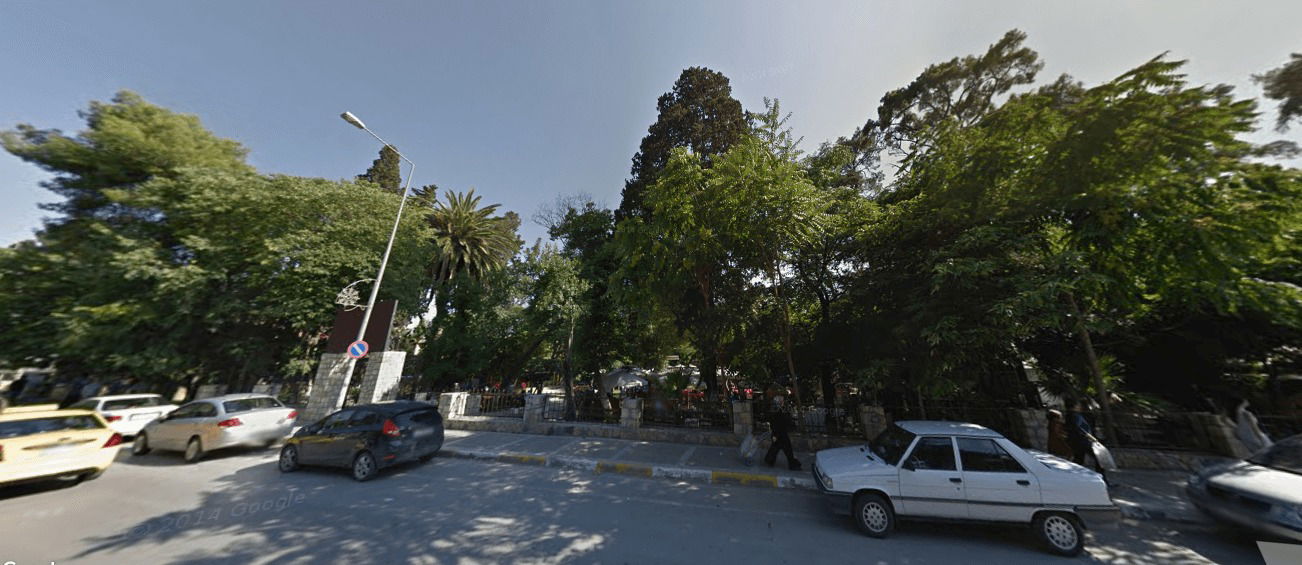 William Blackler Mansion was once located in this park on Menderes Street.
William Blackler Mansion was once located in this park on Menderes Street.
- Sevastopoulos Houses -
The reason why Sevastopoulos Houses are called plural is that there is a series of houses between the Protestant Church and the Capuchin Monastery. This Greek family, who originally came to Buca from Chios, was wealthy and engaged in some commercial activities in Izmir. In addition, although they were Greeks, they also established kinship relations with European families in Buca.
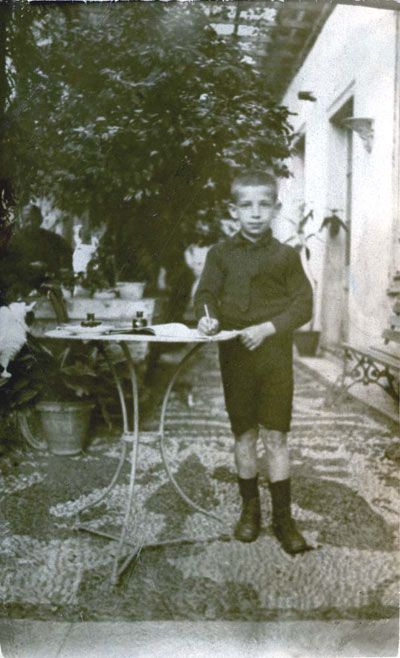 Sevastopoulos Houses, 1925 (Photo: Levantine Heritage)A Greek writer named Kararas, in his book titled "Buca: Izmir's flower village", mentions that there are two giant mausoleums in the Greek Cemetery in the garden of Yukarı Aya Yani Church. One of them belongs to the Sevastopoulos family. Pandeli Sevastopoulos, the head of this family coming from the Byzantine/Chios tradition, is one of the leaders of the Greek community in Izmir. As stated before, there are gardens and houses on the land between the Protestant Church and the Capuchin Monastery. However, since it would not be possible to have a garden and houses on this small land, it can be assumed that they owned land in the area higher up, which today constitutes the Yaylacık neighborhood.
Sevastopoulos Houses, 1925 (Photo: Levantine Heritage)A Greek writer named Kararas, in his book titled "Buca: Izmir's flower village", mentions that there are two giant mausoleums in the Greek Cemetery in the garden of Yukarı Aya Yani Church. One of them belongs to the Sevastopoulos family. Pandeli Sevastopoulos, the head of this family coming from the Byzantine/Chios tradition, is one of the leaders of the Greek community in Izmir. As stated before, there are gardens and houses on the land between the Protestant Church and the Capuchin Monastery. However, since it would not be possible to have a garden and houses on this small land, it can be assumed that they owned land in the area higher up, which today constitutes the Yaylacık neighborhood.
According to Alex Baltazzi, the Sevastopoulos family was closely related to the Baltazzi family. He came from a noble family of Byzantine origin that settled on Chios in 1583. This family was also the founder of the Evangelical School and the Greek Hospital. There was the letter 'S' at the entrance of the garden. Baltazzi stated that these houses were demolished over time and the land was included in the land of the Kapuchin Monastery (now Buca Girls' Orphanage). Today, there is no trace of the house left.
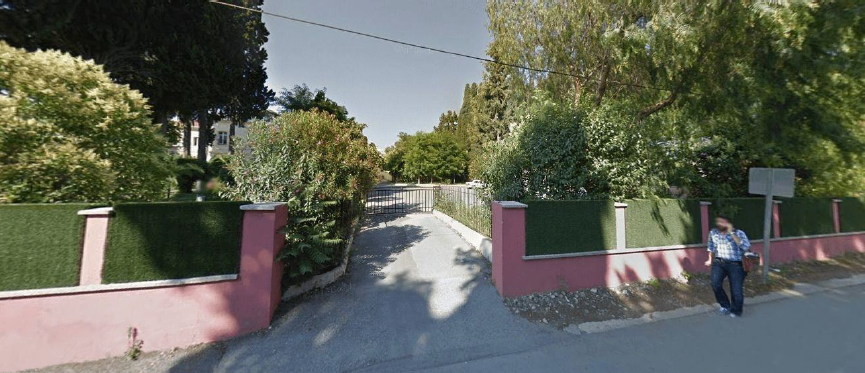 There were once Sevastopoulos houses in this area between the Protestant Church and the Capuchin Monastery.
There were once Sevastopoulos houses in this area between the Protestant Church and the Capuchin Monastery.
- Fred and Julia Gout House -
There is not much information about this house. It was probably built in the late 1800s or early 1900s and was first owned by the Gout family. It is known that the Gout family is a large family in Buca and has houses in various places. Various Levantine families lived in this house in the following years. It was across the street from Statue Square, diagonally from the Manoli Hotel, directly opposite the Hole Mansion. Today, there is a wedding hall on site.
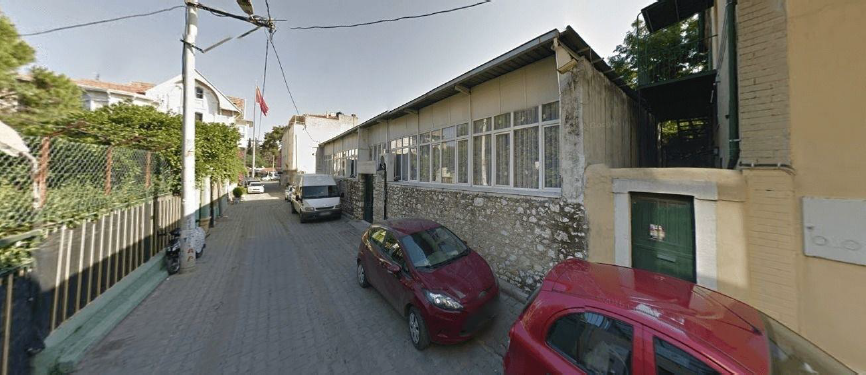 The Fred and Julia Gout House has now been converted into a wedding hall, but the garden walls still remain.
The Fred and Julia Gout House has now been converted into a wedding hall, but the garden walls still remain.
- Aliberti Mansion -
The construction date of Aliberti Mansion is in the early 1900s. The first owners of the land were the De Jongh family. The De Jongh family moved to what is now known as the De Jongh Mansion to protect themselves from air raids during the First World War. They came back home after the war ended.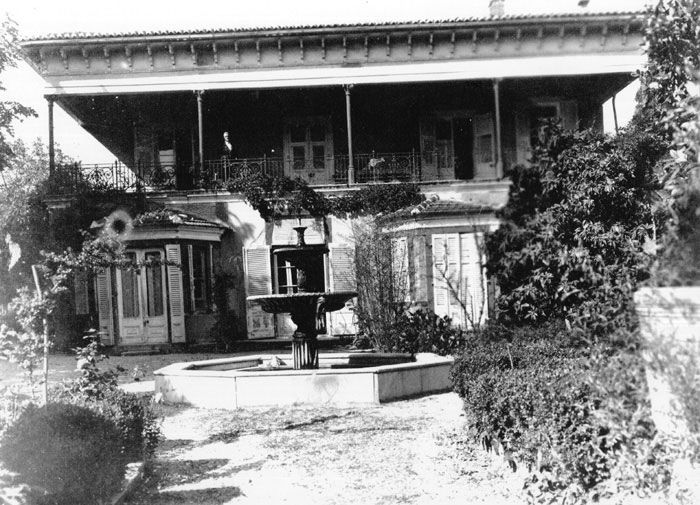 Aliberti Mansion was undoubtedly one of the most elegant buildings in Buca (Photo: Levantine Heritage)The mansion later passed to the Aliberti family. It was used by the Aliberti family for many years. During the years it was in use by the Aliberti family, it became famous for its garden layout and various fruit trees. There was a pool in the middle of the garden and there were ornamental fish in it. Sezar Aliberti, who worked in a hospital in Alsancak, was examining the people of Buca free of charge. The Aliberti family also owned vineyards close to today's Equestrian Club. They were producing tobacco and grape wine. When Count Sezar Aliberti, who was loved by the people of Buca, passed away in 1967, his coffin was carried by people from all walks of life. After Count Aliberti died, the Aliberti family decided to move to Bornova and sold the mansion. When they left, they took the famous ornamental pool in the garden of the mansion with them. The mansion, which was used as a student dormitory for a while, was expropriated by the state. In the following period, it was decided to use the large land to the north of Hasanağa Garden, including the Aliberti Mansion, as a faculty. The house, which remained abandoned for many years and lost its elegance, was eventually demolished in the 1980s and a faculty was built in its place.
Aliberti Mansion was undoubtedly one of the most elegant buildings in Buca (Photo: Levantine Heritage)The mansion later passed to the Aliberti family. It was used by the Aliberti family for many years. During the years it was in use by the Aliberti family, it became famous for its garden layout and various fruit trees. There was a pool in the middle of the garden and there were ornamental fish in it. Sezar Aliberti, who worked in a hospital in Alsancak, was examining the people of Buca free of charge. The Aliberti family also owned vineyards close to today's Equestrian Club. They were producing tobacco and grape wine. When Count Sezar Aliberti, who was loved by the people of Buca, passed away in 1967, his coffin was carried by people from all walks of life. After Count Aliberti died, the Aliberti family decided to move to Bornova and sold the mansion. When they left, they took the famous ornamental pool in the garden of the mansion with them. The mansion, which was used as a student dormitory for a while, was expropriated by the state. In the following period, it was decided to use the large land to the north of Hasanağa Garden, including the Aliberti Mansion, as a faculty. The house, which remained abandoned for many years and lost its elegance, was eventually demolished in the 1980s and a faculty was built in its place.
The Aliberti House was undoubtedly one of the most aesthetically elegant houses of Buca, and while the Barff and Rivens houses were preserved, it is still a question mark why the Aliberti House was demolished.
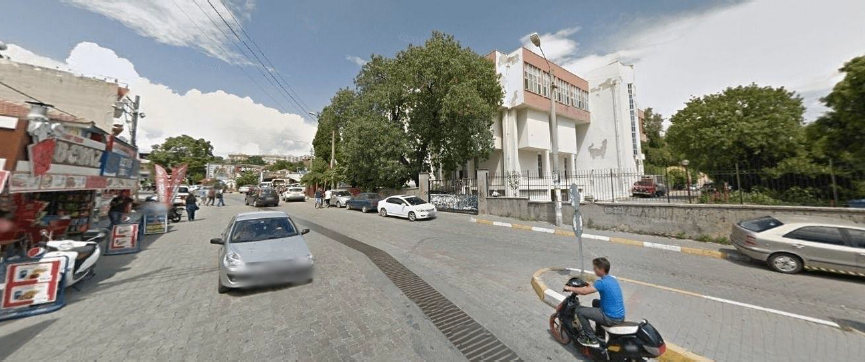 Today, there is a big faculty building on the site of the Aliberti Mansion. All that remains are the giant trees of the garden.
Today, there is a big faculty building on the site of the Aliberti Mansion. All that remains are the giant trees of the garden.
- Gout Mansion -
There is no information about Gout Mansion. It is only known that the first owners were the Gout family and the date of construction should be in the 1700s. Swedish traveler Frederic Hasselquist must have stayed in this house in 1749. This is also the mansion that Lord Byron visited in 1810. It is known that Lord Byron was the guest of his friend the Gout family and wrote some of his poems here. Rumor has it that Lord Byron carved his name on a tree here, and then the place where the name was engraved was cut from the tree and taken to England as a souvenir. In 1816, British traveler William Turner also stayed at the Gouts' house.
It is known that the Gout Mansion, which was once located in the north of Hasanağa Garden, on the land where Dokuz Eylül University Dokuzçeşmeler Campus is located today, survived until the 1950s. The Gout family is a family that came to Izmir in 1792 and is one of the oldest and most established Levantine families in Buca. In their early years, they dealt with carpet exports to England. It is known that they went bankrupt in 1865. According to William Blackler, one of the two most magnificent mansions in Buca, along with the Lee Mansion, was the mansion belonging to the Gouts. The Gout family sold this land together with their mansion to the Bliss family in 1890. The Bliss family demolished this mansion and built a new mansion in 1894.
- Bliss Mansion -
The old mansion on land previously owned by the Gouts was sold to the Bliss family in 1890. The Bliss family demolished the old mansion and built their own mansion in its place in 1894. It is known that the wooded promenade, called 'Byron Passage' in memory of Lord Byron's visit and formed in two rows of cypress trees, extending from the entrance of the garden to the house, continued to exist during this period.
It is known that Robert Pickering Ashe, one of the pastors of the Buca Protestant Church, and her family rented the mansion for a while, but it is not clear whether they rented it before or after the Gordon family.
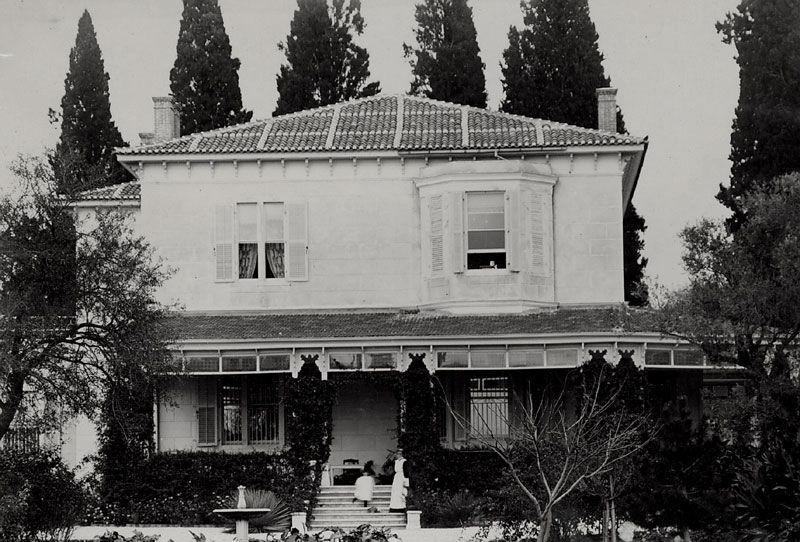 Bliss Mansion, late 19th century (Photo: Levantine Heritage)It was sold to the Gordon family in 1902 by the Bliss family. When the Gordon family owned the mansion, the large land in the north was called 'field'. Horse breeding was done here and there were probably horse stud farms as well. It is not known whether the 'field' land, which was also owned by the Bliss family before the Gordon family, was owned by the Gout family before that. However, considering that Lord Byron is mentioned to have visited a large area of land, it can be estimated that the Gout family probably also owned this land. Today, this land, like the mansion's own land, is within the borders of Dokuz Eylül University Dokuzçeşmeler Campus. After Stephen Gordon died in 1913, the mansion was sold to a Turk by his widow. In documents belonging to Nancy Stevenson, it is stated that the building remained empty for a while before 1922. It is understood from here that the Turkish family bought the house after the war. Nothing remains of the house, which had a water well until the 1970s.
Bliss Mansion, late 19th century (Photo: Levantine Heritage)It was sold to the Gordon family in 1902 by the Bliss family. When the Gordon family owned the mansion, the large land in the north was called 'field'. Horse breeding was done here and there were probably horse stud farms as well. It is not known whether the 'field' land, which was also owned by the Bliss family before the Gordon family, was owned by the Gout family before that. However, considering that Lord Byron is mentioned to have visited a large area of land, it can be estimated that the Gout family probably also owned this land. Today, this land, like the mansion's own land, is within the borders of Dokuz Eylül University Dokuzçeşmeler Campus. After Stephen Gordon died in 1913, the mansion was sold to a Turk by his widow. In documents belonging to Nancy Stevenson, it is stated that the building remained empty for a while before 1922. It is understood from here that the Turkish family bought the house after the war. Nothing remains of the house, which had a water well until the 1970s.
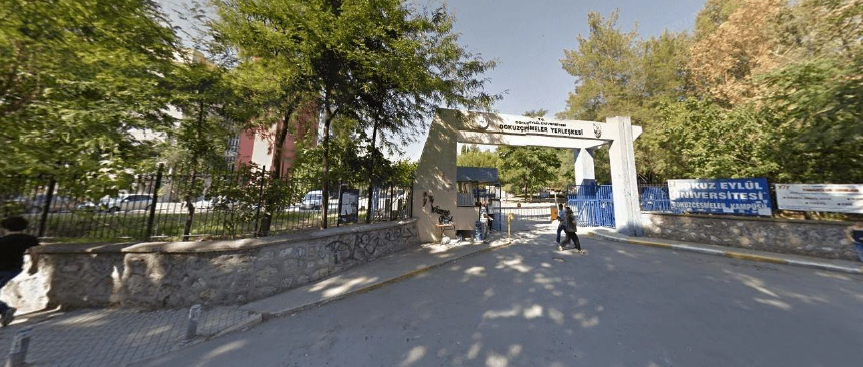 Bliss Mansion was located slightly ahead of the entrance gate of DEÜ Dokuzçeşmeler Campus.
Bliss Mansion was located slightly ahead of the entrance gate of DEÜ Dokuzçeşmeler Campus.
- Werry Mansion -
Although it is known that the first owners of the mansion were the Werry family, there is no extensive information. The Werry family was a diplomatic and influential family. Afterwards, the McVittie family lived in the house. In 1922, the McVittie family left the house and sold it shortly afterwards, probably to a Turkish family.
There is no information about its owners in the first years of the Republic. It is known that after the Levantines left, the well-kept state of the garden was lost, but various trees, especially laurel and almond trees, continued to be in the garden for many years. It belonged to a Turkish family in the 1940s. In the following years, it was used as a hostel and was called Green Mansion by the people of Buca. After burning in the 1950s, it was demolished in the 1970s and the land of the mansion has remained empty since then. Additionally, a few scenes of the movie Wounded Eagle were shot here in the 1960s. Today, the land where the mansion is located is covered with olive trees and there is a coffee house inside. The chimney of the mansion managed to survive until 2016, but it collapsed in a storm in the winter of 2016.
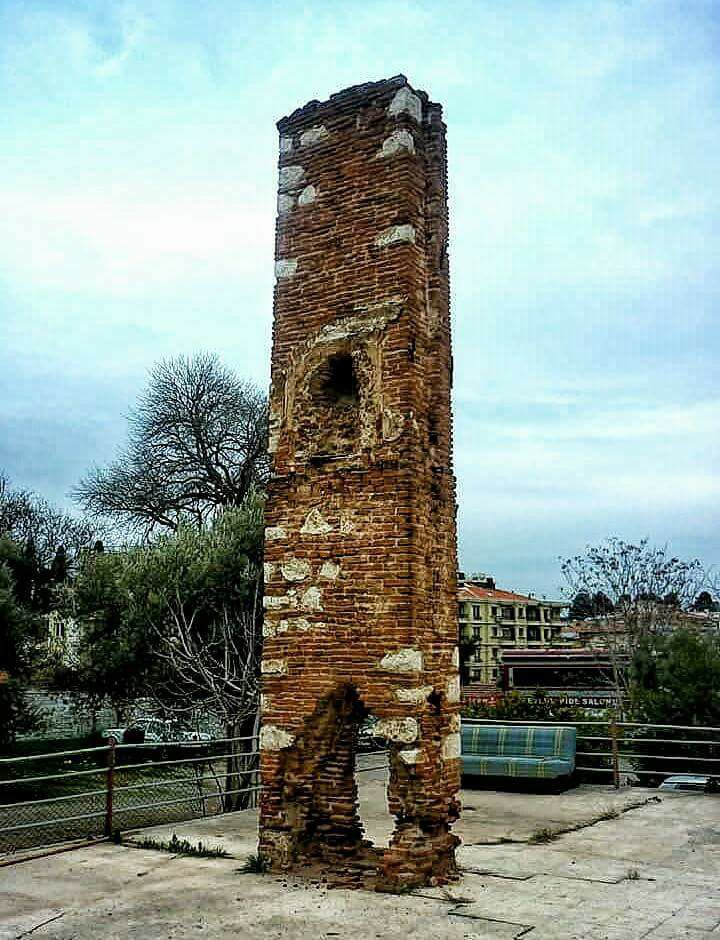 The house chimney, the only remaining artifact from Werry Mansion, was also recently destroyed
The house chimney, the only remaining artifact from Werry Mansion, was also recently destroyed
- Aliotti Mansion -
The main owners of Hasanağa Garden, which is the most important recreation area in the center of Buca today, were the Italian Levantine Aliotti family in the past. The Aliotti family owned very large lands around the Aegean Region and they were the family with the largest land in Buca. There is no information that Enrico Aliotti, the head of the Aliotti family, and his brother Albert Aliotti stayed in Buca permanently. The Aliotti family probably used Buca as a summer resort. Despite this, Aliotti Garden was lushly forested and there was a small zoo in the garden. There were exotic animals in the zoo.
 A photograph of the Aliotti Mansion taken when it was intact in the early 1900sIn 1926 (according to some sources, 1925), the Aliottis sold the land and the mansion to Ödemişli Hasan Ağa. In the early 1930s, Aliotti Mansion burned down. After it burned, Hasan Agha did not bother with the restoration of the mansion and moved to a new, large house he had previously built in the northwest of the garden. He also rented out some residences in the garden.
A photograph of the Aliotti Mansion taken when it was intact in the early 1900sIn 1926 (according to some sources, 1925), the Aliottis sold the land and the mansion to Ödemişli Hasan Ağa. In the early 1930s, Aliotti Mansion burned down. After it burned, Hasan Agha did not bother with the restoration of the mansion and moved to a new, large house he had previously built in the northwest of the garden. He also rented out some residences in the garden.
According to Anadolu newspaper, which published an article titled 'Alyoti Park' dated 1925, Aliotti Garden was purchased by Sarıgöllü Hasan Ağa for four thousand British liras in 1925. There was an elegant mansion in the middle of the garden, and a few meters away from this mansion was a rock decorated with pools and fountains made by skillful hands.
Today, only one double-sided entrance staircase remains from the mansion.
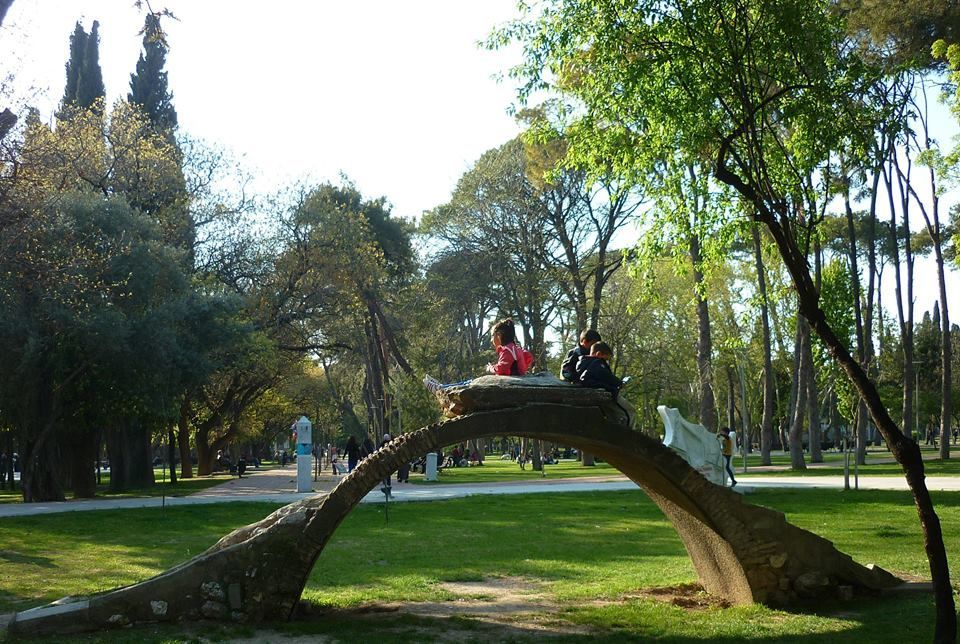 The only remaining structure from the Aliotti Mansion is the two-way entrance staircase
The only remaining structure from the Aliotti Mansion is the two-way entrance staircase
- Hasanağa House -
It is known that after Ödemişli Hasan Ağa purchased the Aliotti land in 1926 (according to some sources, 1925), he had two stone houses built in the southwest and northwest corners of the land. Neither house has survived to the present day.
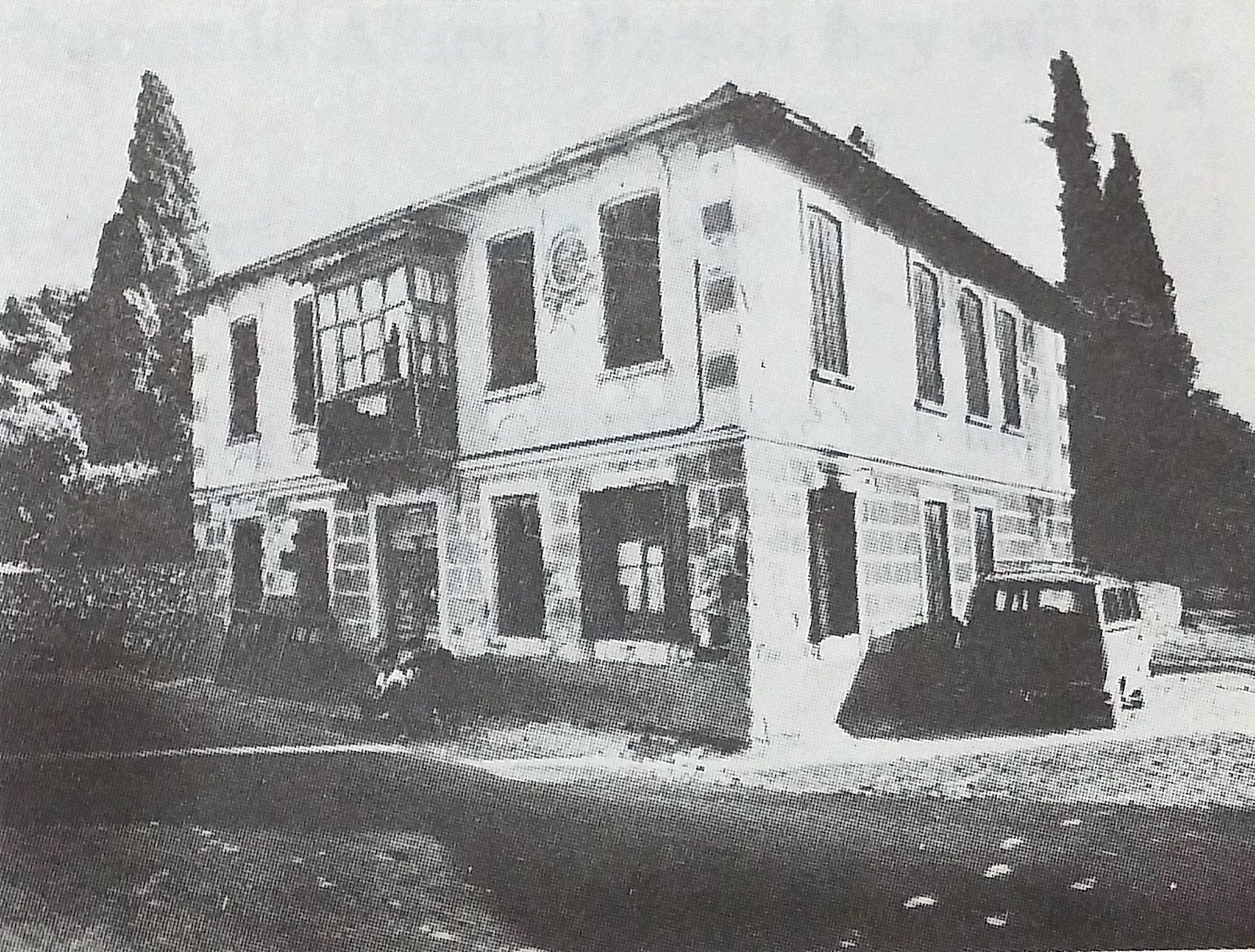 A photograph of Hasanağa's house taken in the 1980s (Photo: Buca'da Konut Mimarisi (1838-1934), Feyyaz Erpi, 1987)Hasanağa lived in the large stone house in the northwest, and there is no information about who inherited the house after his death in 1938, but it is known that the family moved back to Ödemiş in 1938. It is known that it was used by the British during the Second World War. In the following years, it was used as the residence of the caretakers of Hasanağa Garden for a while. The house survived until the 1980s, when it was demolished.
A photograph of Hasanağa's house taken in the 1980s (Photo: Buca'da Konut Mimarisi (1838-1934), Feyyaz Erpi, 1987)Hasanağa lived in the large stone house in the northwest, and there is no information about who inherited the house after his death in 1938, but it is known that the family moved back to Ödemiş in 1938. It is known that it was used by the British during the Second World War. In the following years, it was used as the residence of the caretakers of Hasanağa Garden for a while. The house survived until the 1980s, when it was demolished.
This house, reflecting classical Turkish architecture, was built with fine workmanship. According to Feyyaz Erpi, the fact that the house was built with such fine workmanship is an indication that the architecture did not collapse completely after the Greeks left Buca and that there were still people in Buca who had the knowledge to do fine workmanship.
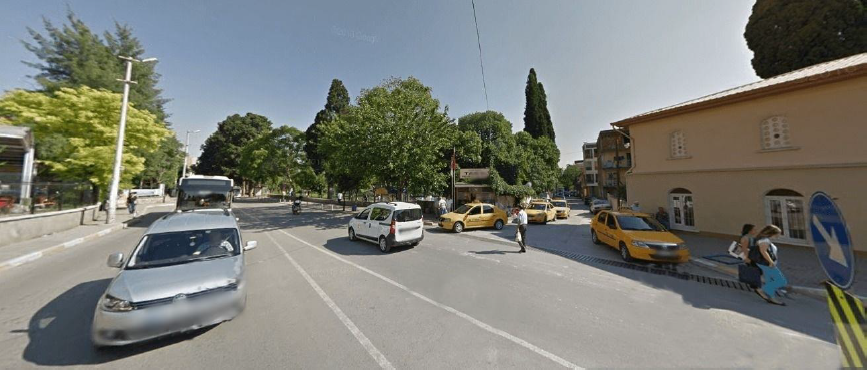 Hasanağa's house was located right behind the taxi stand
Hasanağa's house was located right behind the taxi stand
- Filipucci House -
There is not much information about the house belonging to the Filipucci family, one of the Italian Levantines. It was built in 1959. It is one of the new generation Buca houses built after the 1950s, like the houses of the Roels, Sponza and Micaleff families built on the Şirinyer road at the western exit of Buca, and has no resemblance to classical Buca architecture. The house, which passed to the Romano family, the second generation of the Filipuccis, in the following years, was not in the status of a historical monument because it was built in a late period, and therefore it was recently demolished without encountering any obstacles and an apartment building was erected in its place.
Note: Interestingly, no photo of the house could be found.
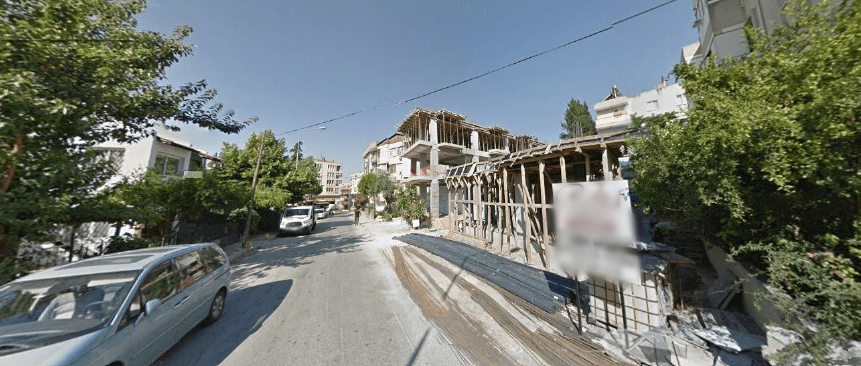 The Filipucci House has been demolished and two apartment buildings are being erected in its place.
The Filipucci House has been demolished and two apartment buildings are being erected in its place.
3. Ruined mansions in Buca
- Stephanie Farkoh Mansion -
It was built by Greek architect Vafiyadis between 1903 and 1906. It was used by the Syrian Christian (Assyrian) Farkoh family until 1965.
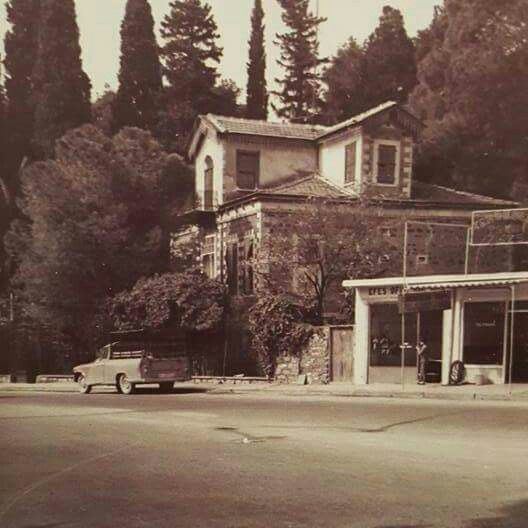 Stephanie Farkoh Mansion served the people of Buca as a clinic for many years (Photo: Anonymous)This house, which was Doctor Selçuk Bey's practice from the 1980s to 1995, was severely damaged as a result of a suspicious fire while it was lying empty in the following years. Although it was in a state of restoration in the early 2000s, the mansion could not be restored as a result of a dispute between the owners of the house and the municipality. According to another claim, bureaucratic problems and obstacles imposed by the Monuments Board prevented the restoration of the mansion. The mansion has collapsed and become a ruin in recent years.
Stephanie Farkoh Mansion served the people of Buca as a clinic for many years (Photo: Anonymous)This house, which was Doctor Selçuk Bey's practice from the 1980s to 1995, was severely damaged as a result of a suspicious fire while it was lying empty in the following years. Although it was in a state of restoration in the early 2000s, the mansion could not be restored as a result of a dispute between the owners of the house and the municipality. According to another claim, bureaucratic problems and obstacles imposed by the Monuments Board prevented the restoration of the mansion. The mansion has collapsed and become a ruin in recent years.
The story of Stephanie Farkoh Mansion is proof of how history disappears when local and central governments do not protect historical heritage. Although it is at a central point in Buca Heykel, where thousands of people pass by every day, the mansion has almost disappeared in plain sight over the years.
Although some attempts have been made to restore the mansion in recent years, no results have been achieved.
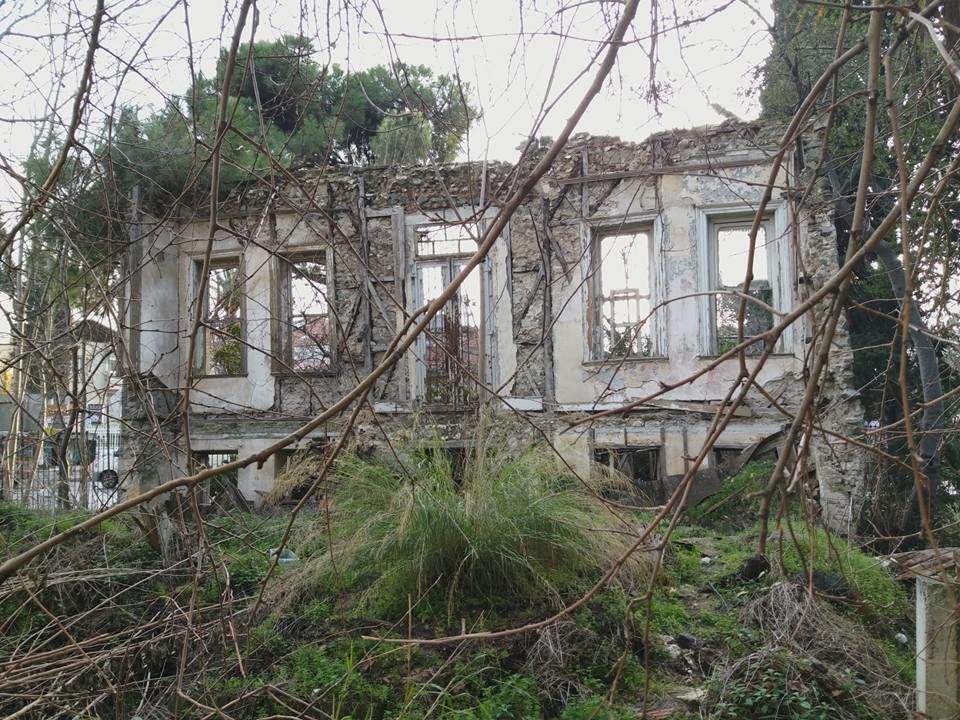 The mansion has collapsed and become a ruin in recent years.
The mansion has collapsed and become a ruin in recent years.
- Mıssır Mansion -
The construction date of the Egyptian Pavilion dates back to the late 1800s. It is estimated that the first owners of the mansion were most likely the Forbes family, and after selling the mansion to the Egyptians, they built their own famous mansion on a dominant hill in the southwest of Buca.
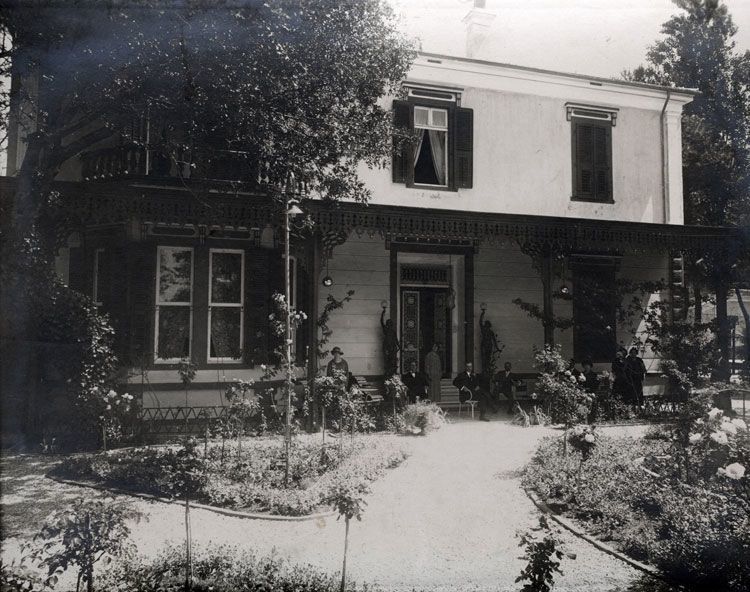 Missir Mansion, early 20th century (Photo: Levantine Heritage)The Missir family in Buca was a large family and was engaged in trade in many areas, especially the fruit business. They first came to Izmir in the 1740s, escaping from the oppression of Christians in Iran. It was a very influential and well-established family and had close ties with the Roman Church. Charles Mıssır, the head of the Missır family in Buca, was importing fruit from Turkey to the USA. In addition, he was the one who built the theater in Izmir. In addition, he brought the first central heating system in Buca to the Egyptian Mansion.
Missir Mansion, early 20th century (Photo: Levantine Heritage)The Missir family in Buca was a large family and was engaged in trade in many areas, especially the fruit business. They first came to Izmir in the 1740s, escaping from the oppression of Christians in Iran. It was a very influential and well-established family and had close ties with the Roman Church. Charles Mıssır, the head of the Missır family in Buca, was importing fruit from Turkey to the USA. In addition, he was the one who built the theater in Izmir. In addition, he brought the first central heating system in Buca to the Egyptian Mansion.
Although the Missir family left Izmir in 1922, they came back after the war. Although they were happy to see that their mansion was untouched when they came to Buca, things did not go well for the Missır family after that. There are no Greek villagers in Buca anymore and therefore there are no qualified personnel left who understand the dried fruit trade. As a result, at least in Buca, they have remained far from their old days. Charles Mıssır died in 1927, and after that, it is seen that the Mıssır family dispersed to places such as the USA and Athens, and some of them stayed in Izmir and mixed with families such as Paterson and De Jongh.
The Egyptian Mansion later passed to a Turkish family. It is known that it was used as a dormitory in the 1970s. The following years are literally the beginning of the end for the mansion. After being abandoned for a long time, it was severely damaged by a fire in 2014 and left to its own fate, and began to decay over time. It is in a very bad condition today and if restoration is not done urgently, it will collapse within a few years.
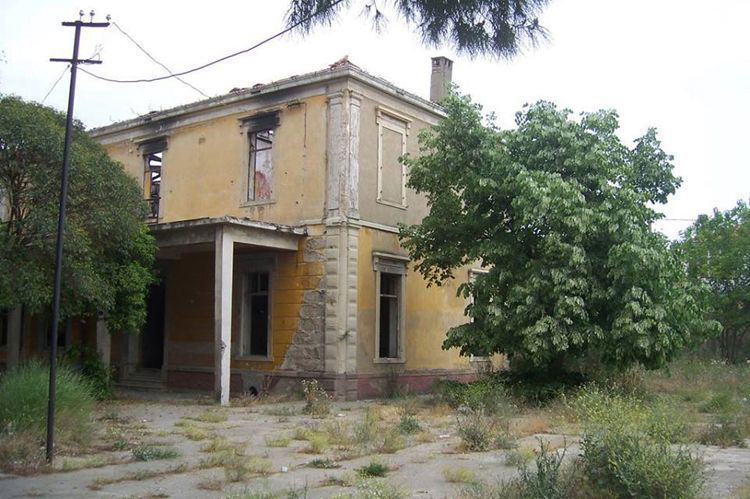 If urgent restoration is not carried out, it is only a matter of time before Missir Mansion collapses
If urgent restoration is not carried out, it is only a matter of time before Missir Mansion collapses
- Renda Mansion -
There is no information about the historical building known as Buca Renda Mansion. It was called "Horozlu Mansion" by the old people of Buca. It was used as a post office in the 1950s.
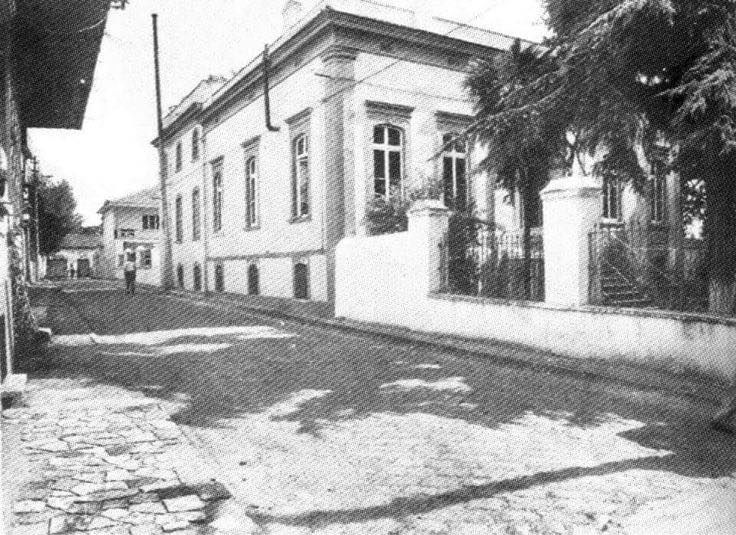 Renda Mansion, probably when it was used as a school (Photo: Buca'da Konut Mimarisi (1838-1934), Feyyaz Erpi, 1987)Renda Mansion was used as the administrative building of Çamlaraltı College from 1960 to 1976, and then as the administrative building of Buca Commerce High School. The building, which was evacuated in 1995, turned into ruins over time. Buca District and Provincial Directorates of National Education reported the status of the building to the Izmir Cultural and Natural Heritage Preservation Board many times from 1998 to 2006, but the Izmir Cultural and Natural Heritage Preservation Board did not allow intervention in the building without preparing the survey and restoration projects. Buca Municipality installed a metal barrier around the building after it collapsed towards the road in 2003. Renda Mansion, which has become even more ruined today with the collapse of most of its side walls, has been recorded as another historical monument that has apparently disappeared as a result of the indifference of the administrations.
Renda Mansion, probably when it was used as a school (Photo: Buca'da Konut Mimarisi (1838-1934), Feyyaz Erpi, 1987)Renda Mansion was used as the administrative building of Çamlaraltı College from 1960 to 1976, and then as the administrative building of Buca Commerce High School. The building, which was evacuated in 1995, turned into ruins over time. Buca District and Provincial Directorates of National Education reported the status of the building to the Izmir Cultural and Natural Heritage Preservation Board many times from 1998 to 2006, but the Izmir Cultural and Natural Heritage Preservation Board did not allow intervention in the building without preparing the survey and restoration projects. Buca Municipality installed a metal barrier around the building after it collapsed towards the road in 2003. Renda Mansion, which has become even more ruined today with the collapse of most of its side walls, has been recorded as another historical monument that has apparently disappeared as a result of the indifference of the administrations.
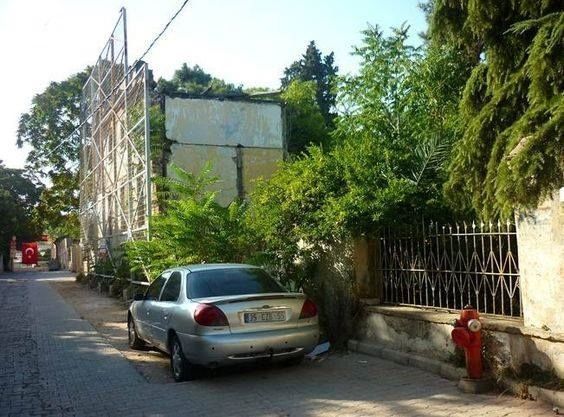 As with many historical monuments in Buca, a barricade has been built here and the death of the historical building is expected.
As with many historical monuments in Buca, a barricade has been built here and the death of the historical building is expected.
- Hacılar House -
It is estimated that the house, which is named after the Drama immigrant family named Hacılar, lived in it after the Republic, served as a model for the Russo Mansion. Only the lower part of this house, which has a masonry lower part and a wooden upper part and mosaics at the entrance, has survived to this day.
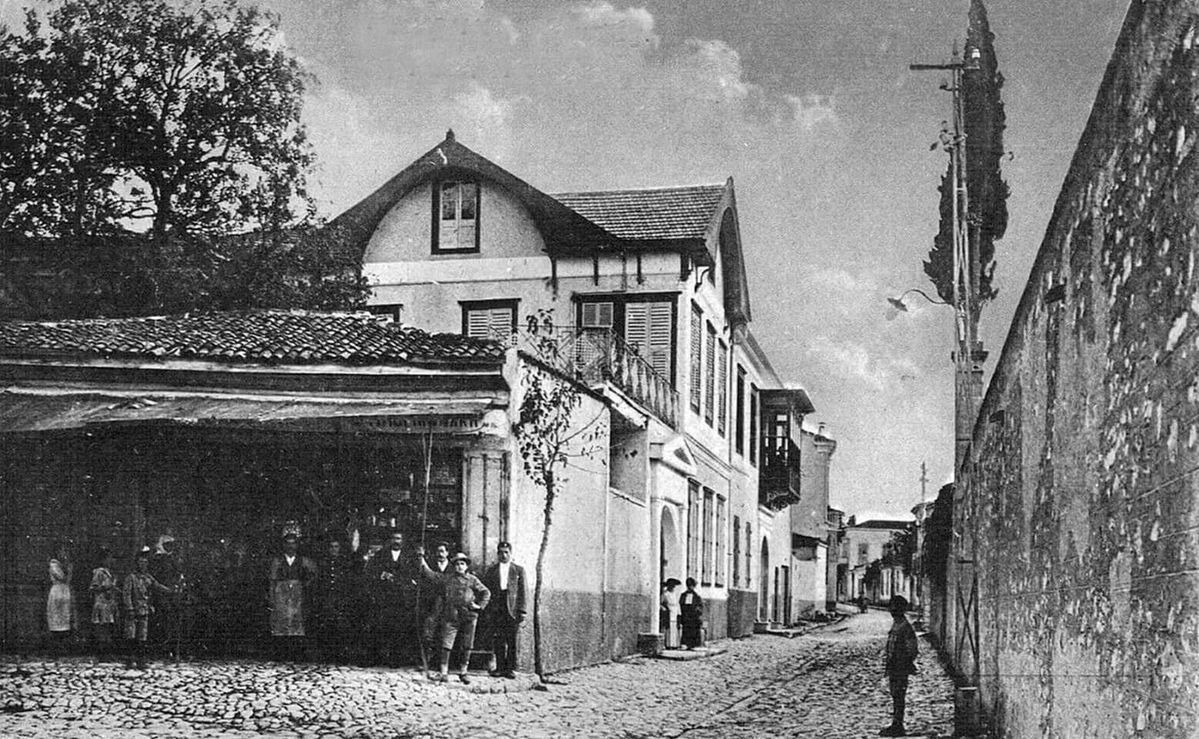 It was most likely used as a shop or coffee house by a Greek, as seen at the front in this early 20th century photo.Although it belonged to a Greek family before the Republic, it was most likely used as a grocery store or butcher's shop. There is no information about how he came to the Hacılar family after the Republic.
It was most likely used as a shop or coffee house by a Greek, as seen at the front in this early 20th century photo.Although it belonged to a Greek family before the Republic, it was most likely used as a grocery store or butcher's shop. There is no information about how he came to the Hacılar family after the Republic.
It was used by the Hacilar family until the 1930s. It was both lived in and run as a grocery store by the Ural family in the 1950s and 1960s. In the following years, it was transferred to another family and was used as a dough maker and kadayıf maker for a while. The house was severely damaged as a result of a fire in 1999. Today, only the outer wall and the entrance gate remain standing.
 The current state of Hacılar House
The current state of Hacılar House
- Marcel Balladur House -
Although it is estimated that the first owners of this house, located on Buca's Erdem Street, between Hacılar and Nicola Aliotti house, were the Balladur family, since Chios is an area where Greeks are concentrated, there is a strong possibility that the first owners were a Greek family.
Although the Balladur family is known as a French and Levantine family, it is a family of Armenian origin whose ancestors migrated from Nakhchivan to Anatolia.
Pierre Balladur, the head of the Balladur family, had three daughters and three sons. Edouard Balladur, who would be the Prime Minister of France between 1993-95, is the youngest of the boys and he spent his childhood in this house. The house changed hands when the Balladur family migrated to Marseille in 1935, but it is known that not all of the Balladur family left Buca at that time. Edgar Balladur, the last person living under the name Balladur in Buca, died in 1984. In addition, Charles Balladur, another member of the Balladur family, became the first person to enter the mass car production business in Turkey through his close relations with the Ford company in the 1930s.
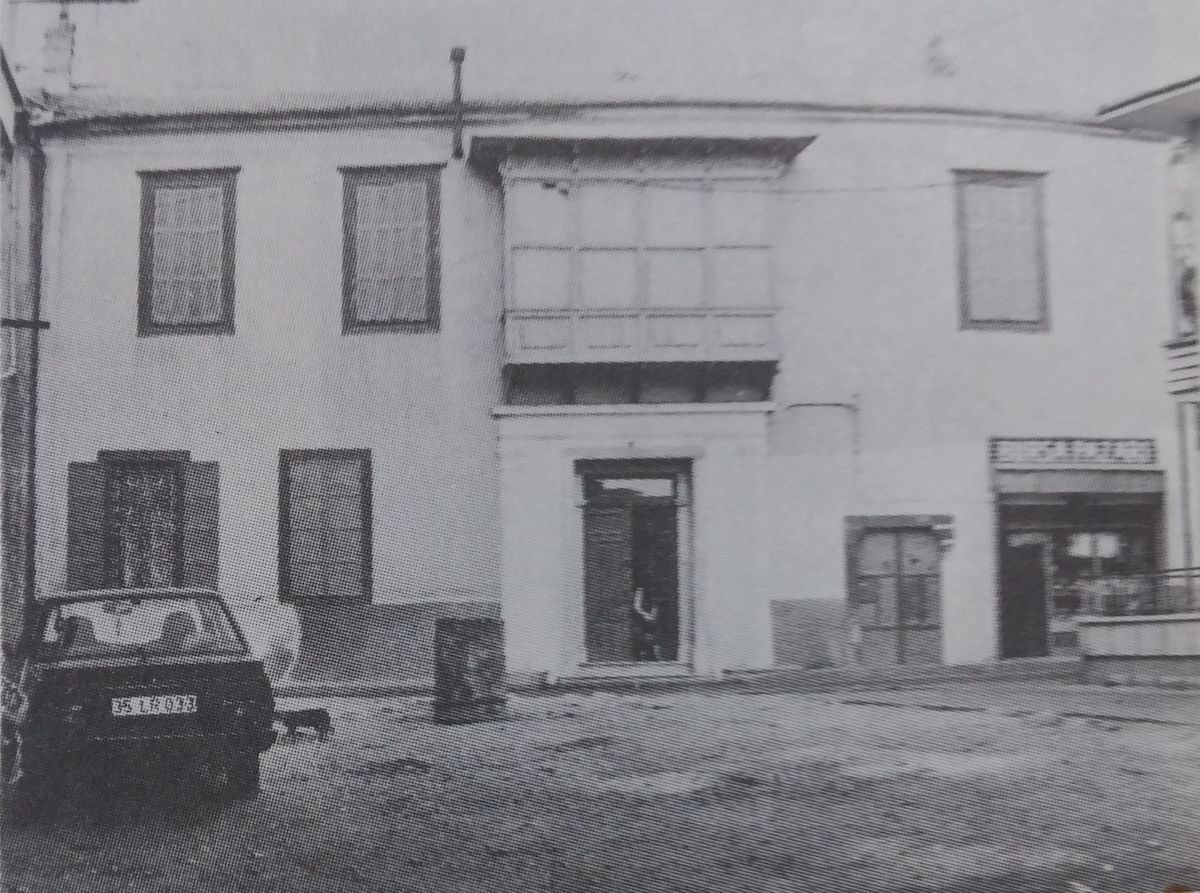 Marcel Balladur House in the 1980s when it was used as bazaar (Photo: Buca'da Konut Mimarisi (1838-1934), Feyyaz Erpi, 1987)Antuan Karakulak also gave some information about the house and the Balladur family during his interview. According to Karakulak, Edouard Balladur, who would later become the Prime Minister of France, went to France at the age of 16-17 to do his military service and never returned. The Balladur family emigrates to Austria and France. They sell the house to a Turkish family from Afyon for 125,000 liras. After running a market called 'Bursa Pazarı' for years, the Turkish family rents it out.
Marcel Balladur House in the 1980s when it was used as bazaar (Photo: Buca'da Konut Mimarisi (1838-1934), Feyyaz Erpi, 1987)Antuan Karakulak also gave some information about the house and the Balladur family during his interview. According to Karakulak, Edouard Balladur, who would later become the Prime Minister of France, went to France at the age of 16-17 to do his military service and never returned. The Balladur family emigrates to Austria and France. They sell the house to a Turkish family from Afyon for 125,000 liras. After running a market called 'Bursa Pazarı' for years, the Turkish family rents it out.
Marcel Balladur House, along with the adjacent Pilgrims House, suffered a suspicious fire in 1999. Afterwards, it collapses and turns into ruins. Today, only the outer wall remains standing.
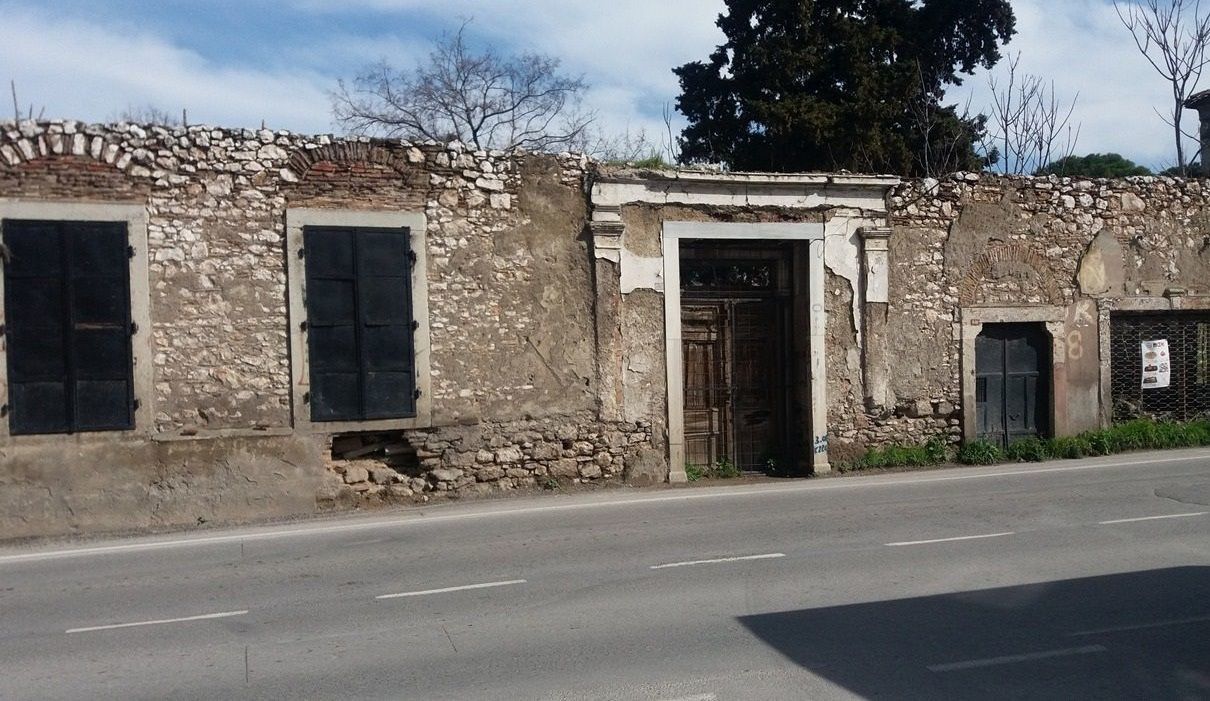 Today, just like the Hacılar House on its left, only its outer wall remains standing
Today, just like the Hacılar House on its left, only its outer wall remains standing
- Nicola Aliotti House -
There is not much information about the house. It is known as the Nicola Aliotti house because it is occupied by the Aliotti family. It was described as the Nicola Aliotti House by Rose Marie Caporal, who lived in Buca for many years. In addition, Alex Baltazzi mentioned that members of the Balladur family also lived here when he was alive. It follows that it was used at various times by the Balladur and Aliotti families. In the following years, it was used by the Yalaz family, a Turkish family.
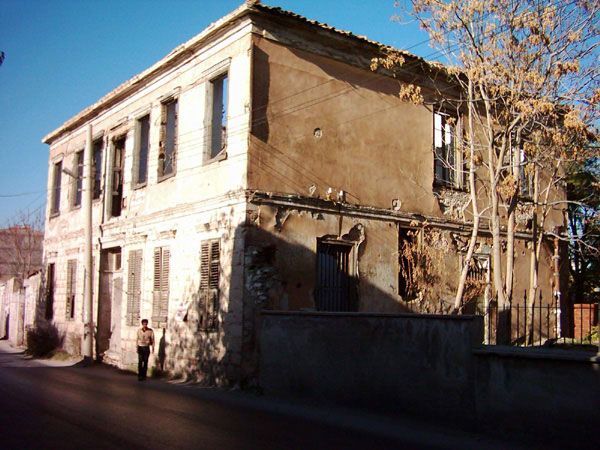 Nicola Aliotti House, early 2000s (Photo: Levantine Heritage)The Nicola Aliotti House has become unusable since the 1970s. Its restoration was brought to the agenda in the 1980s, but its restoration was rejected by the Izmir Survey and Monuments Directorate and it collapsed further over time and became a ruin today. Today, it is increasingly collapsing and is among the structures that need urgent restoration.
Nicola Aliotti House, early 2000s (Photo: Levantine Heritage)The Nicola Aliotti House has become unusable since the 1970s. Its restoration was brought to the agenda in the 1980s, but its restoration was rejected by the Izmir Survey and Monuments Directorate and it collapsed further over time and became a ruin today. Today, it is increasingly collapsing and is among the structures that need urgent restoration.
- Petter House -
It is located on Buca Erdem Street, right opposite the Ernest Balladur House, and is in ruins today. There is no information about him. The only information that can be learned was given by Antuan Karakulak. Karakulak said that the house belonged to the British Petter family.
 Petter House, probably in the 1970s (Photo: Anonymous)It is estimated that this old house, belonging to the British family named Petter, is one of the oldest houses still standing in Buca. Completely wood was used in the construction of the building. Considering that wooden houses were used in Buca until the half of the 1800s and that the use of stone houses became widespread after an earthquake in those years, it can be said that the house is at least 150-160 years old. Unfortunately, despite this unique feature, Petter House has been abandoned to its fate for many years without any intervention.
Petter House, probably in the 1970s (Photo: Anonymous)It is estimated that this old house, belonging to the British family named Petter, is one of the oldest houses still standing in Buca. Completely wood was used in the construction of the building. Considering that wooden houses were used in Buca until the half of the 1800s and that the use of stone houses became widespread after an earthquake in those years, it can be said that the house is at least 150-160 years old. Unfortunately, despite this unique feature, Petter House has been abandoned to its fate for many years without any intervention.
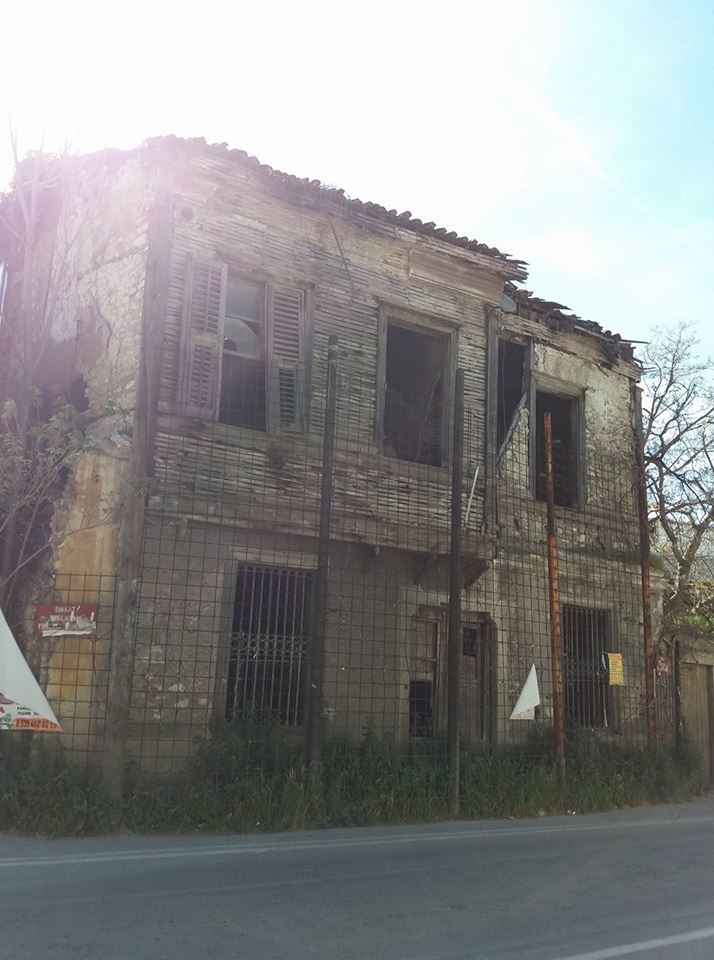 Petter House, which is one of the unique Buca architectures with its wooden structure, is almost left to decay today.
Petter House, which is one of the unique Buca architectures with its wooden structure, is almost left to decay today.
Additional Maps
Map of today's historical buildings in Buca
Map of structures that have not survived to the present day in Buca
Click for the interactive map showing the historical buildings of Buca.
This article was created by atalarimizintopraklari.com. All rights reserved. All or part of this article cannot be used in books, magazines or newspapers without citing the source.
- Sources -
levantineheritage.com/note41.htm
levantineheritage.com/weber.htm
levantineheritage.com/testi5.htm
yapi.com.tr/haberler/tarihi-renda-kosku-coktu_3647.html
Buca, Nikos Kararas, 1962
Buca'da Konut Mimarisi (1838-1934), Feyyaz Erpi, 1987